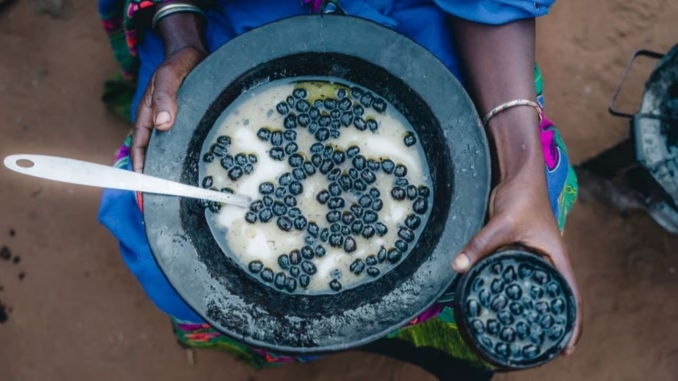

In Oromia, Ethiopia, a centuries-old custom turns espresso right into a meal—a ceremony of nourishment and connection.
BY TEWODROS BALCHA
BARISTA MAGAZINE ONLINE
Pictures courtesy of Go to Oromia
In Ethiopia’s southwest, espresso sizzles earlier than it steams. Butter melts over beans, releasing a smoky, nutty aroma that indicators not a drink—however a meal.
Among the many Guji folks of Oromia, a centuries-old custom generally known as Buna Qalaa transforms espresso from beverage to sustenance. The beans are simmered complete in butter and milk, and eaten collectively: a ritual that blurs the road between nourishment and ceremony, style and belonging.
“’Buna Qalaa’ actually means ‘slaughtered espresso,’” says Nega Wedajo, Deputy Commissioner of the Oromia Tourism Fee. “It refers to a ritualized espresso meal woven into social life—utilized in ceremonies, blessings, and formal gatherings. It’s not simply meals. It’s an emblem of fertility, well-being, and neighborhood connection.”
Nega is one in all many Ethiopians working to achieve world recognition for Ethiopian espresso, together with the traditional practices that heart across the beverage. “Traditions like Buna Qalaa are treasures,” Nega advised Barista Journal. “They maintain communities on the heart and present the world that espresso is life—not only a drink.”
The Making of Buna Qalaa
In response to Nigatu Elias Dukelle, Head of the Espresso High quality and Certifications Heart on the Ethiopian Espresso and Tea Authority’s Bule Hora Department, the preparation of Buna Qalaa is each exact and poetic—a choreography of endurance, scent, and sound.
Solely ripe espresso cherries are handpicked and sun-dried complete, their parchment nonetheless intact. Earlier than cooking, the tip of every bean is barely lower, historically with the enamel, to assist the butter seep in.
A clay pot known as kelo is heated till faintly smoking. Butter melts first, then the beans are gently stirred in till they attain a lightweight, even roast—by no means darkish or burnt. The buttery beans are transferred right into a picket bowl, the kori, and sizzling milk, boiled in the identical pot, is poured again in, coating every bean. Lastly, the combination is served in a cup generally known as mudunu.
“The butter penetrates the bean and enriches it,” Nigatu advised Barista Journal. “You chew it slowly, and it stays in your mouth like gum for hours. It fills you deeply. Individuals say it provides long-lasting power and even retains the enamel clear.”


Espresso for Each Passage
Buna Qalaa marks almost each threshold of life—childbirths, naming ceremonies, weddings, reconciliations, and even the shut of mourning. Within the Borana Gadaa system, it’s supplied by elders as an indication of respect and continuity.
Past nourishment, Buna Qalaa is believed to revive vitality, maintain endurance, and renew social concord. Ready in silence or in tune, its aroma fills the house, summoning reminiscence and connection: a sensory bridge between generations.
As Ethiopia seeks recognition from the United Nations Academic, Scientific and Cultural Group (UNESCO) for its conventional espresso ceremony, regional expressions like Buna Qalaa are additionally gaining visibility.
By means of initiatives akin to Go to Oromia’s Tour de Espresso and digital collaborations with Google Arts & Tradition, vacationers are discovering espresso not simply as a drink, however as a dwelling heritage. “Guests who expertise Buna Qalaa describe it as sluggish, sensory, and unforgettable,” Nega Wedajo says.
Nega additionally emphasizes that tourism round Buna Qalaa should stay community-led: “This isn’t a efficiency—it’s a dwelling tradition. We wish vacationers to study straight from native custodians, and we guarantee the advantages return to them.”


Custom Meets Specialty
For Nigatu, who bridges heritage and the specialty espresso sector, Buna Qalaa represents innovation by way of preservation.
“Specialty espresso talks lots about terroir and traceability,” he says. “However traditions like Buna Qalaa present one other layer—the human terroir. Once you eat espresso as an alternative of consuming it, you style the land, the butter, and the fingers that made it. It’s a full sensory connection to origin.”
He believes the ritual holds classes for the worldwide espresso business: “We spend a lot power refining taste within the cup. However right here, taste is tied to nourishment—to espresso as power, neighborhood, and care. Perhaps cafés right this moment can study from that: Typically, innovation means returning to the supply.”
A International Reflection
In fashionable cafés, the place precision and presentation outline excellence, Buna Qalaa presents a humbler however deeper lesson—that espresso’s truest which means lies not in its extraction, however in its sharing.
Its tempo and ritual echo modern actions towards mindfulness, sustainability, and authenticity. It reminds us that espresso’s richness just isn’t solely sensory however social: a bridge between nourishment and narrative.
As Nega places it: “In each chunk of Buna Qalaa lies a quiet reality: Espresso started as communion, not competitors. In a world chasing novelty, this ritual whispers one thing timeless—typically the way forward for espresso is present in its oldest kind: eaten, not sipped; shared, not bought.
ABOUT THE AUTHOR
Tewodros Balcha (Teddy) hails from Ethiopia, a coffeeland the place the bean is life-vital. As a connector of Ethiopian and broader African espresso cultures, he shares the continent’s vibrant heritage with the world.
Subscribe and Extra!
As at all times, you may learn Barista Journal in paper by subscribing or ordering a problem.
Learn the October + November 2025 Situation without cost with our digital version.
Free of charge entry to greater than 5 years’ value of points, go to our digital version archives right here.


